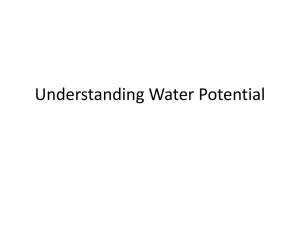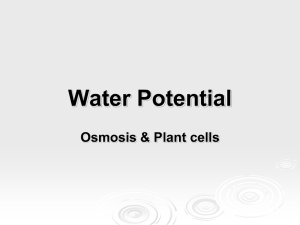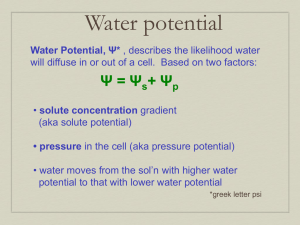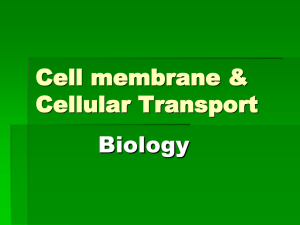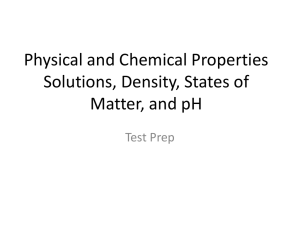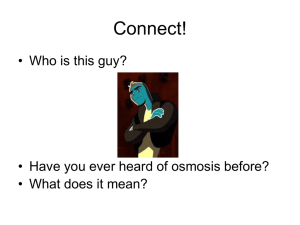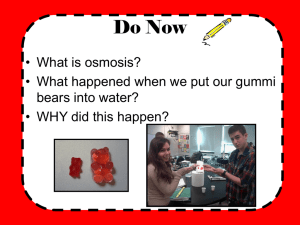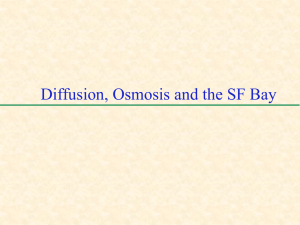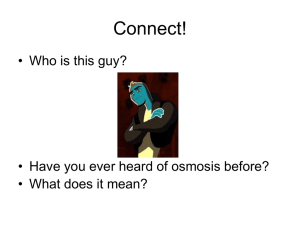Hot Seat - Cell Membrane Structure _ Function
advertisement
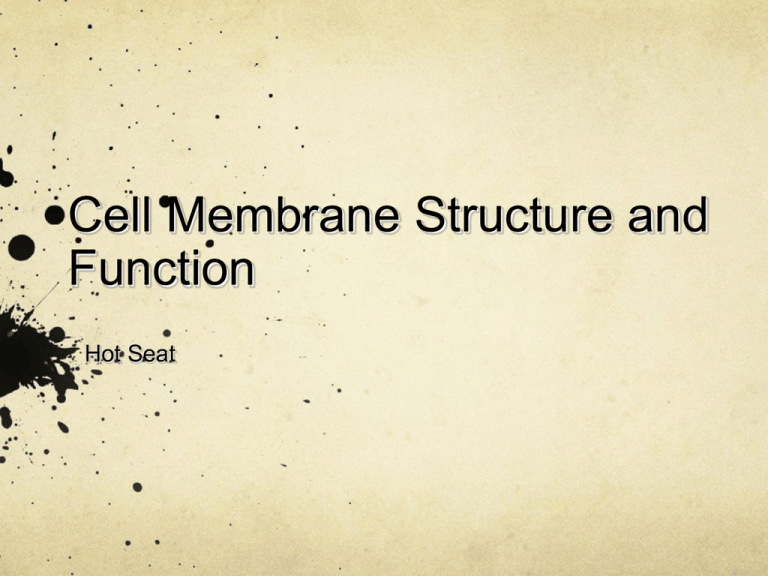
Cell Membrane Structure and Function Hot Seat Rules A. You are competing against classmates in your row (across the classroom). The hot seat is the seat in each row closest to the outside windows. B. Your answer must be written and you must stop writing when the teacher says, “pencils down” C. After hearing the correct answer you will check your answer with the person to your left and the person to your right. D. If your answer is correct and the person to your right answered incorrectly you move into their seat (towards the hot seat) and they will move into yours. E. If your answer is incorrect and the person to your left answered correctly, you move into their seat (away from the hot seat) and they will move into yours. F. Remember you may only move one seat at a time! If you get it right and two people in front of your get it wrong you still can only move one seat! Which cell structure helps the cell maintain homeostasis by controlling what enters and leaves the cell? A. Cell Membrane Predict the concentration of solute molecules on each side of the membrane after 24 hours. Label “A” and “B” below A. Phospholipids B. Transport Protein or Protein Channel A B When a membrane is said to be selectively permeable, this means that _______. A. half of the membrane is permeable and the other half is not B. the membrane is permeable part of the time C. the cell regulates what passes in and out D. only large molecules can pass through Which of the following supports the picture shown below? A. The concentration of solute in the cell was higher than in the solution so water entered the cell. B. The concentration of solute in the cell was lower than in the solution so water left the cell. C. The concentration of solute in the cell was higher than in the solution so water left the cell. D. The concentration of solute in the cell was lower than in the solute was water entered the cell. Which of the following supports the picture shown below? A. The concentration of solute in the cell was higher than in the solution so water entered the cell. B. The concentration of solute in the cell was lower than in the solution so water left the cell. C. The concentration of solute in the cell was higher than in the solution so water left the cell. D. The concentration of solute in the cell was lower than in the solute was water entered the cell. Which of the following correctly explains the picture? A. The concentration of solute in the cell was higher than in the solution so water entered the cell. B. The concentration of solute in the cell was lower than in the solution so water left the cell. C. The concentration of solute in the cell was equal to the concentration in the solution so water is moved into the cell D. The concentration of solute in the cell was equal to the concentration in the solute so the cell is at equilibrium. Which of the following correctly explains the picture? A. The concentration of solute in the cell was higher than in the solution so water entered the cell. B. The concentration of solute in the cell was lower than in the solution so water left the cell. C. The concentration of solute in the cell was higher than in the solution so water left the cell. D. The concentration of solute in the cell was lower than in the solution so water entered the cell. Which of the following correctly explains the picture? A. The concentration of solute in the cell was higher than in the solution so water entered the cell. B. The concentration of solute in the cell was lower than in the solution so water left the cell. C. The concentration of solute in the cell was higher than in the solution so water left the cell. D. The concentration of solute in the cell was lower than in the solution so water entered the cell. Choose the best definition of diffusion: A. The movement of molecules from an area of high concentration to an area of low concentration. B. The movement of molecules from an area of low concentration to an area of high concentration. C. The movement of water molecules from an area of high concentration to an area of low concentration. D. The movement of water molecules from an area of low concentration to an area of high concentration. What is the difference between active transport (AT) and facilitated diffusion (FD)? A. AT requires protein carriers; FD does not. B. AT requires energy; FD does not. C. AT requires a concentration gradient; FD does not. D.AT requires a cell membrane; FD does not. Which method is used by O2 and CO2 to cross the cell membrane? A. Active Transport B. Facilitated Diffusion C. Diffusion D. Osmosis Which of the following substances requires a transport protein in order to cross a membrane? A. O2 B. CO2 C. Glucose D. Na+ E. Both C and D Most scientists do not classify viruses as living things because A. Viruses do not contain DNA B. Viruses do not contain protein C. Viruses are not made of organic compounds. D. Viruses need a host cell to reproduce. Will the cell shrivel, swell, or stay the same? 8% sugar 1% sugar Predict the concentration of solute on each side of the membrane after 24 hours A. Equal concentration on both sides The movement of water from an area of high water concentration to an area of low water concentration is called A. active transport B. Diffusion C. Osmosis D. facilitated diffusion A cell surrounded by a more concentrated solution A. loses water and shrinks B. gains water and expands C. gains and loses the same amount of water, staying the same shape D. none of the above A cell surrounded by a less concentrated solution A. loses water and shrinks B. gains water and expands C. gains and loses the same amount of water, staying the same shape D. none of the above A cell surrounded by a solution of the same concentration A. loses water and shrinks B. gains water and expands C. gains and loses the same amount of water, staying the same shape D. none of the above Celery sticks left in a dish of freshwater for several hours become stiff and hard. Similar celery sticks left in a saltwater solution become limp and soft. From this we can deduce that freshwater is ________ and the saltwater is ___________ to the cells of the celery sticks. A. less concentrated, more concentrated B. more concentrated, less concentrated C. less concentrated, less concentrated D. more concentrated, more concentrated The smell of ammonia spreading throughout a room would be an example of_______. A. Diffusion B. Facilitated Diffusion C. Osmosis D. Active Transport Which section of the cell membrane is hydrophobic? A. The tails of the phospholipids Hydrophilic (polar) Hydrophobic (non-polar) Which section(s) of the cell membrane are hydrophilic? A. The heads of the phospholipids Hydrophilic (polar) Hydrophobic (non-polar) What is the difference between a solute and a solvent? A. A solute is the thing being dissolved and a solvent is the liquid doing the dissolving. B. Remember water is the universal solvent! Which of the following would be an example of osmosis? A. The smell of ammonia spreading through the room. B. The shriveling of a snail after salt is poured on it C. Water being poured into a glass D. The absorption of water by a bathroom sponge. A state of biological balance maintained by living organisms is called.. A. Exocytosis B. Osmosis C. Homeostasis D. cytolysis Does the picture demonstrate passive or active transport? Movement of substances across the membrane without the use of cellular energy is termed A. Active transport B. Carrier transport C. Passive transport D. Protein transport What must a virus do to reproduce? A. Invade a host cell. If the cell below has a glucose concentration of 20 ppm, which of the following concentrations of the solution would cause the cell to swell? A. 10 ppm B. 20 ppm C. 30 ppm D. 40 ppm Will the cell shrivel, swell, or stay the same? 84% sugar 96% sugar Will the cell shrivel, swell, or stay the same? 87% sugar 87% sugar Dialysis is the process by which an artificial kidney machine removes waste products from a patients’ blood. The dialysis membrane has openings that allow salts and other wastes dissolved in the blood to pass through without expending any energy. This is an example of (passive / active) transport. A. Passive Transport Inside bag A is a 50% glucose solution and inside bag B is a 30% glucose solution. Both bags are put into beakers containing 100% water. A. Bag A will swell. B. Bag B will swell. C. Both bags will swell. 50% D. Both bags will shrivel E. Both bags will remain the same. 100% 30% What relationship between surface area and volume must organisms achieve to ensure efficient delivery of nutrients A. keep surface area and volume equal B. maximize surface area and minimize volume C. minimize surface area and maximize volume D. none of these Is the concentration of the solute in the solution greater than, less than, or equal to the concentration of the solute in the cytoplasm of the cell? A. The concentration of solute in the solution is greater than the concentration of solute in the cytoplasm of the cell. Cells must have ways to maintain homeostasis. Which is an example of ways cells can do this? A. A) Plant cells have a cell wall to keep from bursting B. B) Fresh water single-celled animals constantly pump water out C. C) Eggs have shells to keep them from dehydrating D. D) All of the above are examples If a plant cell contains more solutes than its surrounding environment A. The cell will burst B. Water will enter the cell C. Water will leave the cell D. There will be no net movement of water The concentration of calcium in a cell is 0.3%. The concentration of calcium in the fluids surrounding the cell is 0.1%. How could the cell obtain more calcium? A. Facilitated diffusion B. Active transport C. Osmosis D. diffusion Which cell has the largest surface area to volume ratio? Identify one difference and one similarity between facilitated diffusion and active transport? Facilitated Diffusion Active Transport A. Use proteins A. Use proteins B. No Energy B. Energy C. High Conc. To Low C. Low Conc. To High Conc. D. Both transport bigger molecules that can’t cross through the phospholipids. Conc. D. Both transport bigger molecules that can’t cross through the phospholipids. Which of the following is NOT a type of passive transport? A. Diffusion B. Osmosis C. Protein pumps D. Facilitated diffusion What will happen to an animal cell placed in a salt water solution? A. The cell will shrink B. The cell will expand C. The cell will burst D. The cell will shrink and then expand and then shrink again An animal cell placed in a solution of lower solute concentration will: A. Die B. take on water C. lose water D. Divide Which of the following is a type of active transport? A. sodium potassium pump B. osmosis C. diffusion D. Facilitated diffusion Active transport requires A. a concentration gradient B. osmosis C. energy D. a hypertonic solution
